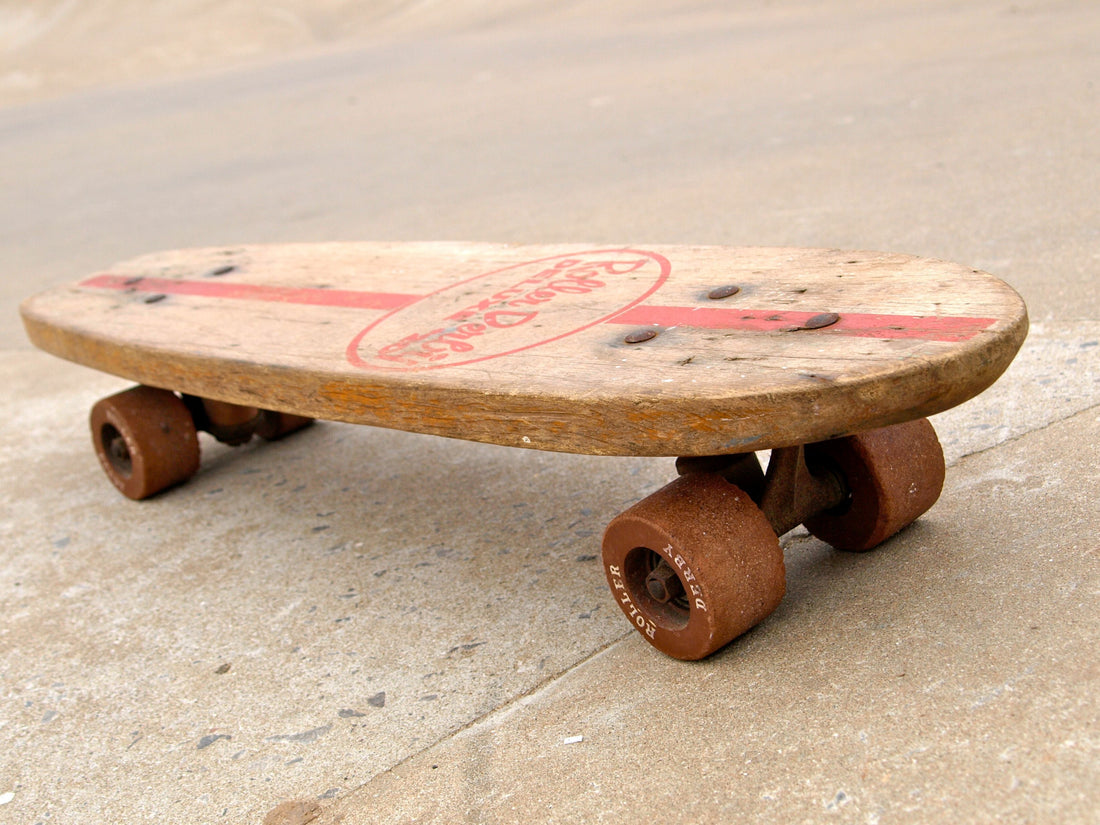Skateboarding Through the Decades... 1950's - Today
Rebellious and unapologetic from the beginning, skateboarding has been a unique sport from its inception. Created without rules, guidelines or a need to be defined it has always celebrated individuality from the old school freestylers to today's transition shredders. With a cultural evolution along the way it's easy to say skateboarding is more than just a sport, it's a culture and a lifestyle.
1950’s
Skateboarding seemed to be a spontaneous invention by a bunch of Californian Surfers in the 1950’s. The surfers where attracted to the idea as it was based on similar movements to surfing so it felt like they were ‘sidewalk surfing’. The design of the board was normally a box with roller skating wheels on the bottom. The wheels were made of clay and were very hard to control. This lack of control resulted in many injuries. Skateboarding was seen as a way to warm up for a surf, a way to have fun after a surf or as something to do when the surf was messy. Slowly the boxes started becoming planks and then decks of pressed layers of wood. At this stage, skating was more longboarding than how we know skating today.
1960’s
Skateboarding was very popular heading into the 60’s. Companies such as Jack’s, Hobie and Makaha began to grow rapidly. These companies tended to be surf companies who then ventured into the early skateboards. These companies also began to organise competitions, mainly downhill slalom or freestyle. In 1965 the first Women’s National Skateboard champion Patti McGee went on to be one of the earliest sponsored skateboarders.
As a 19 year old girl from California she became the spokesperson for the sport with a ‘girl next door’ appeal - travelling throughout the united states to promote skateboarding as a fun liberating activity for everyone. As the 60’s moved on the fad started to fade out. However, some people still had a desire to skate. Yet with parts hard to come by they had to use their imagination and begin to build their own boards.
1970’s
The 70’s started with a major breakthrough. Frank Nasworthy invented urethane skateboard wheels. This is similar to the type of wheel we use today. This invention helped lead to a new found interest in the sport. These wheels were a lot easier to control than the clay ones previously used and prevented many falls and injuries.
Competitions once again began to be organised and the ability of the skaters continued to improve. Skateboarders began to build a lifestyle around the sport. In 1978, Alan Gelfand, who’s nickname was ‘Ollie’, invented a manoeuvre now known as the Ollie. This is the trick that most tricks today are based off or incorporate. Moving into the late 70’s, the insurance rates began to rise rapidly. This lead to a decrease in interest. This declining interest also lead to many skateparks shutting down.
Source: http://www.boredpanda.com/1970-skateboarding-culture-skater-california-locals-only-hugh-holland/
1980’s
Following the closure of many skateparks, skateboarders began to build their own ramps. They also hit the streets and found that the entire world was a potential skate park. This led to skating becoming a more underground movement. The VCR was introduced in the 80’s and this had a large impact on skating.
In 1984, the Bones Brigade filmed the first skateboarding videos. This was revolutionary for the sport. As the 80’s moved on vert skating began to lose its popularity however street skating took off and increased its popularity.
1990’s
After dropping in popularity in the late 80’s, skateboarding once again began to regain its attractiveness. It came back with a more dangerous and adrenalin fuelled attitude. ESPN’s Extreme Games competition in 1995 helped make the sport a lot more appealing to spectators and helped young kids grow an interest in the sport. The skate culture began to grow and continued in growing in influence.
Source: http://cdn.fansided.com/wp-content/blogs.dir/280/files/2014/06/skate-vert.jpg
2000’s
Skateparks once again began to pop up throughout the suburbs. Skating video games and the invention of the internet also helped get kids interested in the sport but also help them educate themselves on tricks, boards and where to skate. Skate events are now televised which increases the amount of money in the skating industry. Currently the next big step for skateboarding is trying to gain entry into the 2020 Olympics in Tokyo.
The vote goes ahead later this year, so watch this space to see if it gets the nomination! In the mean time, grab a board and go have a skate! You can check out where to skate in Sydney here.





